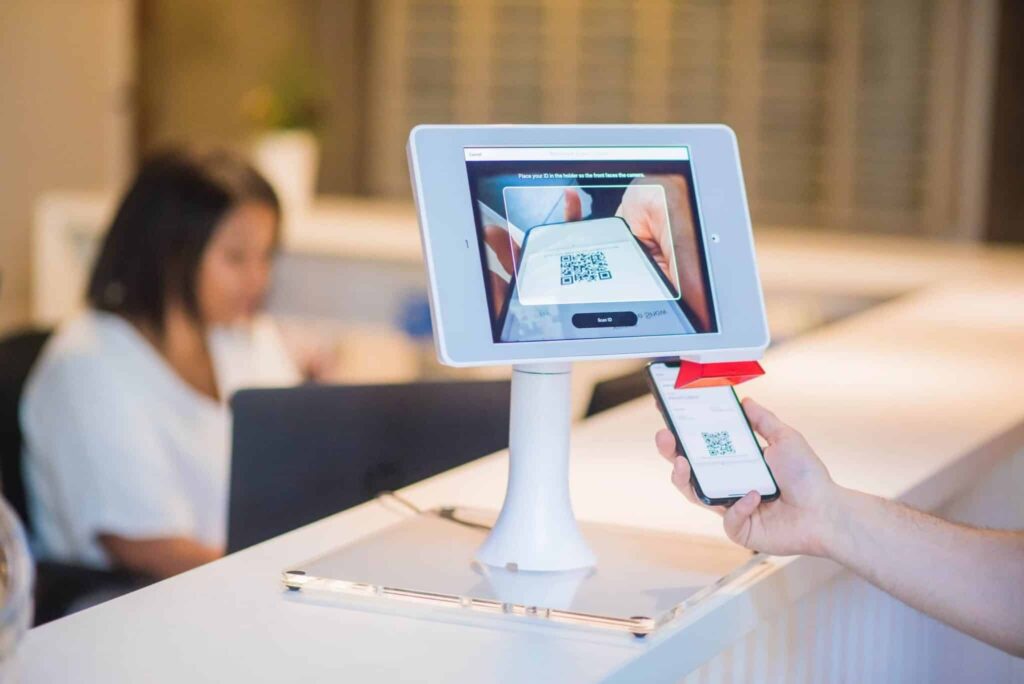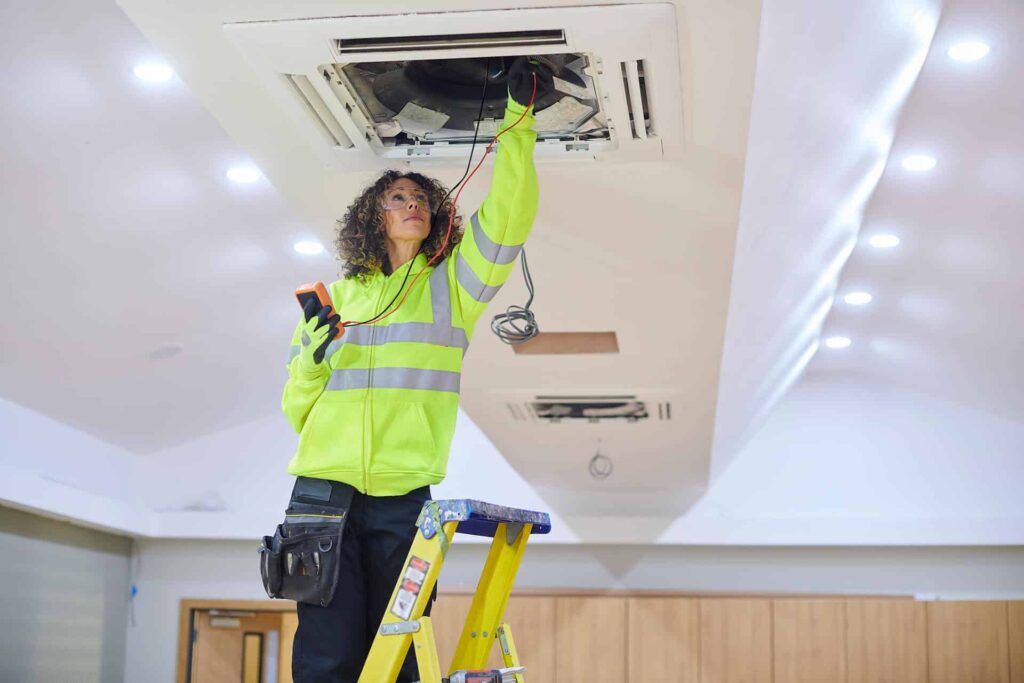Agile working: Create a data-driven agile space to improve the office

Agile working is here to stay—which means companies are embracing agile spaces and flexible work culture like never before.
Companies that embrace agile working are often rewarded with incredibly happy and productive team members.
And companies that use data to create agile spaces that better support their agile teams often enjoy both cost-savings and more future-proof facilities.
In this article, we explore how agile working and resulting agile spaces are impacting work today. We also include how to choose the right metrics to optimize these more dynamic spaces.
What is agile working?
Agile working is as much a workplace philosophy as it is a workplace strategy.
A dramatic shift away from traditional (and typically) strict work styles, agile working empowers employees to choose for themselves when, where, how, and with whom they work. In this context, saying you’re ‘going to work’ doesn’t mean you’re going to the office—at least not for everyone. ‘Work’ is not a place—it’s something you do.
As such, agile working can be implemented in an almost limitless variety of ways. It depends on the needs of both workers and the work they’re doing.
And whether an employee works better when sequestered at home, at a standup desk in a busy spot in the office, by themselves or in a working neighborhood, from 9-to-5 or on a constantly changing schedule that accounts for both pick up and drop off at their kids’ school… More and more companies are adopting agile workspaces and working practices to provide them with this maximum flexibility.
In short, agile methodology is a focus on the activity of work itself. This is versus the time and place of work. It also has a focus on empowering workers wherever they are. It assumes that better results will flow from better workflows and better work-life balance.
When managed properly, agile working can lead to higher productivity and collaboration in the workplace. It can also have a dramatic impact on workplace wellbeing, and employee engagement and experience. This in turn can help to make a more connected workplace and employee centric company culture.
And all these benefits, of course, will usually help improve teamwork, customer satisfaction, and talent attraction and retention efforts (more specific benefits of agile working below).
As such, while every company may not be able to fully adopt agile working, a variety of agile practices (like flexible seating options, for example) are becoming more and more popular.
Hybrid workplaces are often—but not always—agile workplaces
The rise in agile working has gone hand-in-hand with the post-pandemic rise in hybrid work. But the two are not the same thing.
Remember that agile companies care more about the ‘why’ and ‘how’ of work, than they do the ‘who,’ ‘what,’ ‘when,’ and ‘where.’
Hybrid workplaces, meanwhile, focus squarely (and solely) on the ‘where’ of this equation. This is ‘location independent’ working; employees can work in the office, remotely, and/or in a combination of the two. Employees will often have overlapping hybrid schedules, in an effort to ensure both collaboration and real estate needs are met.
So while hybrid work models may require agile practices, ‘hybrid’ is not synonymous with ‘agile.’
That said, agile is one of the most forward-thinking and sustainable ways to create a hybrid workplace that actually works for the people using it.
But of course this assumes that the company understands what’s going on in the office.
Only when armed with good (and real-time) workplace data can facility managers (FMs), space planners, and other decision makers effectively address what’s needed (or not) in any given agile or hybrid space.
Flexible workplaces are often—but not always—agile workplaces
Similarly, agile working is often confused with flexible working.
Flexible working typically refers to limited flexibility around certain aspects of worklife, such as schedule or location.
Meanwhile, an agile way of working is more like ‘flexible plus.’ It brings extreme flexibility and adaptability to all aspects of workflows and decision making.
Note that agile working can also be confused with activity-based working (ABW), another popular workplace strategy.
In ABW, the given task impacts where employees work. This is whether that’s at a desk, in a conference or meeting room, in a phone cubby, or at the coffee shop around the corner.
As such, agile offices typically incorporate ABW practices, but ABW practices alone do not equate to agile working.
A brief history of agile working
Agile working may be newly popular, but it is not a new concept.
The concept originates from software development practices that started to emerge during the 1990s. During this time, some software developers (notably Kent Black, Ward Cunningham, and Jeff Sutherland), started pushing back against ‘waterfall’ methods. These were linear, strict, and heavily regulated. In this case, each phase of a development cycle had to be completed before moving on to the next one.
To counter what were seen as oppressive methodologies, more agile practices like scrums, sprints, unified process (UP), and feature-driven development (FDD) were adopted. These culminated in the now famous Agile Manifesto, published in 2001, which espouses the following four principles:
- Individuals and interactions over processes and tools
- Working software over comprehensive documentation
- Customer collaboration over contract negotiation
- Responding to change over following a plan
While created for software development, it’s easy to see how the underlying premises of these principles extend beyond their original scope. Companies that were able to respond to change (versus strictly following a plan) were those that survived the pandemic. And even before the pandemic, smart and flexible companies were working to center employees and collaboration in their strategy and culture.
It was once the domain of startups and tech companies. But now companies in virtually every industry are looking for ways to bring these agile principles (and more) into their own domain.
“Whatever the arguments over definition and terminology, the goal of agile working is to create more responsive, efficient and effective [organizations] based on more balanced, motivated, innovative and productive teams and individuals. These are essential ingredients in surviving and thriving in the challenging global world in which we operate today.”
Paul Allsopp, Founder of The Agile Organisation
A note on agile practices in the aerospace industry
Note that the process of agile working sometimes refers to agile spacecraft and space software development, too.
Agile aerospace takes the same agile philosophy of rapid iteration to optimize costs, production, and results. Agile Space Industries is a leader in the field, specializing in aerospace propulsion (i.e.: rocket engines and thrusters). Using 3d printing, hot fire tests, and agile additive manufacturing equipment, the company is trusted by NASA, the DoD, and other contractors. Based in Durango, Colorado, it’s helmed by Chris Pearson, Daudi Barnes, Chief Operating Officer Andrew Thompson, and David Cuthbertson (Vice President of Program Delivery).
Ultimately, whether you’re talking about agile space propulsion design or agile office design, propulsion systems or workplace systems, lunar landers, software documentation, or activity based workspace design… More and more workplace leaders in more and more industries are waking up to the importance of not only withstanding change, but embracing it.

What is agile space?
As agile working becomes more widespread, the focus is shifting from the strategy itself, to the spaces that support it.
Simply put, agile space is any that’s been optimized for agile working.
Of course, any simplicity ends there, since there’s no one-size-fits-all or easy roadmap for agile space. Multidimensional working requires multidimensional spaces. And multidimensional spaces need to be carefully optimized with accurate data and advanced workplace analytics.
And one of the goals of an agile environment is often to cut down on the amount of space an organization needs. FMs would therefore be wise to regularly review their corporate real estate requirements, and negotiate new, flexible contracts when possible.
What are the requirements for agile?
Beyond this, agile spaces work best when they provide the following:
- The right technology. Specifically, companies will need to adopt robust communication and workplace collaboration tools to support teamwork. Meanwhile, FMs need powerful space management software that helps manage office space while also collecting and synthesizing critical utilization metrics that can improve spaces going forward.
- The right office arrangements. Specifically, companies need to find a balance that supports the needs of employees when they do come into the office, while also keeping corporate real estate costs in check. To do this, they’ll typically need data surrounding their peak and average space utilization rates.
- The right employee supports. Specifically, employees don’t just need the right spaces—they also need to be able to work comfortably and easily in their chosen framework. This means providing suitable types of workspaces, along with user-friendly desk and room booking software that makes them accessible. Mobile apps, workplace Slack and Microsoft Teams integration, and a Visual Directory that identifies where people and resources are in real time—these all go a long way here. Note that FMs must also ensure everyone working remotely has all the up-to-date tools they need to do so. This will likely require close collaboration with their counterparts in IT to create an optimized digital workspace that works alongside their physical one.
- Good move management. Specifically, while all businesses need to be able to easily react to change, an agile working environment in particular can make change a much more regular occurrence. It should therefore be easy to move employees, both in one-off seat changes and for larger scale relocations. This typically requires first-rate move management software
- The ability to test and iterate. Specifically, optimizing a dynamic office by definition requires the ability to try out new things and see how they work. To create an agile space, companies need to first determine what goals matter most (Productivity? Employee engagement scores? Collaborative culture in the workplace?). From there, they can make changes to their space (and elsewhere) and test whether those changes impact their goals positively or negatively. They can then iterate or change course as necessary.
Ultimately, agile space is essential to agile working.
If employees are only able to do ‘real work’ at the office, or at certain types of workspaces within the office, then they won’t be able to truly embrace agile work. That means that FMs will have to consider all elements of their agile environment. Even an employee’s kitchen table or hotel room. Otherwise, they’ll only be giving lip service to agile working practices .

Agile working demands adaptable workspaces
Like you would expect, agile working requires considerable workplace agility. Employees will need the right in-office tools and spaces to thrive in this type of work environment. And companies may need to regularly pivot those tools and spaces. This is in order to keep pace with changing employee needs and preferences.
Ultimately, each company (and perhaps even different departments or teams within each company) will have to come up with an agile space that is in line with their work and employee requirements.
The good news… Employees are usually on board for more autonomy and flexibility, assuming companies roll out any new agile approaches in the right way.
To ensure greater success and employee buy-in, FMs and companies should work hand-in-hand with employees. They must use real-time data to create a workspace that works best for everyone.
From there, they can begin to implement a variety of new working trends, such as:
- Hot desking and office hoteling, which uses desk booking software to allow employees to share, reserve, and check-in desks
- Agile room booking to enhance collaboration strategies in the workplace, which may include experimenting with new meeting room setup styles
- Office neighborhoods, which use office neighborhood software to ensure employees are able to consistently sit with the people with whom they need or prefer to collaborate
In short, there are many work environment types that can support agile working. In fact, in some ways, it’s the ability to rejig space that makes it ‘agile,’ more so than any office space layout itself.
That’s why space planners need to use sophisticated workplace metrics and presence data to build the right spaces for their people. Only when they understand how employees are currently interacting with their spaces, can they figure out ways to make them better.

Agile spaces demand workplace data
Developing agile workspaces often requires a cultural shift—everyone needs to be on board for a more flexible work culture
But assuming that companies are ready for agile work, then FMs and space planners can begin the office design process.
Like we’ve covered, this process needs to be one of testing and iteration, experimenting with different timelines and workflows. The recommended office space per employee can easily change based on budget or employee experience concerns. What worked a year ago or even months ago may no longer work today. And what works for one team may not work for another.
This extreme complexity will ultimately test planners who need to ensure space utilization never falls below employee needs.
Specifically, they’ll need workplace data analytics. Analytics that provide answers to two critical questions. Whether any workplace changes have an impact on in-office activity and productivity, and whether those changes remain the most efficient use of space over time.
Agile metrics: what to track
Workplace leaders today recognize the importance of leveraging utilization metrics to refine the in-office experience. That said, agile working is still new to many companies. It’s therefore not surprising that, according to the OfficeSpace 2023 Workplace Strategy Report, 70% of leaders want to measure and track their office use, but 49% are unsure about what their goals should be.
Like we’ve already covered, though, there’s no one-size-fits-all approach to agile working or agile space. Companies will need to determine what matters to their bespoke short and long term goals.
“Now is the time to take a step back and understand what is key and really important to your physical office space,” says Johanna Rodriguez, Senior Managing Director of Occupant Experience of Savills, in a recent discussion surrounding hybrid workplace change strategies. “This is an opportunity to realign what you have in your space to what is actually needed. It really comes down to understanding what your business is, what your priorities are, and then aligning the space type in the office space for that need.”
The importance of leveraging multiple data types
Perhaps the more important question when optimizing agile space isn’t what metric to track; it’s how many metrics to track.
Namely, to develop a complete picture of in-office activity (and how well any space changes are impacting it), FMs and space planners will need to leverage data from a variety of sources. They’ll ultimately need to understand complex occupancy rates across time, facilities, and even specific areas of the office
Specifically, companies can and should gather workplace reports and analytics from any, many, or all of the following sources:
- Employee badge data (typically in the form of badge swipes)
- WiFi logs
- IoT sensors (typically in the form of occupancy sensors)
- Room and desk bookings, check-ins, and cancellations
- Tickets submitted through request management software
- Employee surveys and self-reporting
- Manual office censuses, i.e.: ‘walking the floor’
- CRE data
“My advice to companies is that you can’t rely on just one source of data,” says Kathleen Williams, Senior Product Manager at OfficeSpace. “You need to bring your large datasets together to truly solve business problems.”

How does agile space help with space?
Agile space is ultimately a higher performance space. It can serve employees better, while also allowing for more real estate optimization than was typically available in traditional offices. In other words, agile spaces help to create office spaces that are more cost effective and more employee-centric.
The future of work is agile. That means the future of workspaces will be to support this exciting way of working. Just as agile project management can lead to better outcomes, agile space can lead to better workplaces.
OfficeSpace powers agile working, helping companies to create better agile spaces for their employees and their bottom lines. Reach out for a free demo.
Agile working and agile space FAQs
What is an example of agile working?
Dell provides an u003ca href=u0022https://www.officespacesoftware.com/blog/whats-the-difference-between-an-agile-workspace-and-an-activity-based-workspace/u0022 target=u0022_blanku0022 rel=u0022noreferrer noopeneru0022u003eagile work exampleu003c/au003e. The company has a generous remote work policy and remains committed to maintaining and supporting a flexible workforce. u003cbr/u003eu003cbr/u003eu003ca href=u0022https://remote.co/company/dell/u0022 target=u0022_blanku0022 rel=u0022noreferrer noopeneru0022u003eAccordingu003c/au003e to Mohammed Chahdi, the Director, Head of Americas HR operations at Dell, “work flexibility allows team members options for how, where, and when to do their work. These options create a collaborative work environment between the needs of the company and the team member.”
What are the benefits of agile working?
Companies typically adopt agile working practices to increase both productivity and employee experience. This in turn can create a variety of spin-off benefits. Like a more u003ca href=u0022https://www.officespacesoftware.com/blog/inclusive-company-culture/u0022 target=u0022_blanku0022 rel=u0022noreferrer noopeneru0022u003einclusive company cultureu003c/au003e, or easier talent attraction and u003ca href=u0022https://www.officespacesoftware.com/blog/talent-retention/u0022 target=u0022_blanku0022 rel=u0022noreferrer noopeneru0022u003eretentionu003c/au003e efforts. The Agile Organisation also reports that u003ca href=u0022https://www.personio.com/hr-lexicon/agile-working/#does-agile-work-produce-resultsu0022 target=u0022_blanku0022 rel=u0022noreferrer noopeneru0022u003e63% of managersu003c/au003e link revenue growth directly to flexible working.
What is the difference between agile and flexible working?
Agile working and flexible working both allow for more adaptability in the workplace. Their biggest difference comes from their focus. u003cbr/u003eu003cbr/u003eAgile working focuses on u003cemu003ehowu003c/emu003e work is done, while flexible working focuses on u003cemu003ewhenu003c/emu003e and u003cemu003ewhereu003c/emu003e work is done. The goal of agile working is typically to stay responsive to change. While the goal of flexible working is typically to improve employee experience and engagement (among other benefits).
What is the difference between agile working and hybrid working?
Agile working and hybrid working are often confused for each other, although they’re two different approaches to work. Agile working allows for supreme flexibility, allowing employees to work when, where, how, and with whom they choose. It u003cemu003eallowsu003c/emu003e for hybrid working, but it is much more adaptable and responsive than hybrid. u003cbr/u003eu003cbr/u003eHybrid working refers strictly to the ability of employees to work both at home or in the office. Since employees can have more or less control over their hybrid schedules, hybrid working has the potential to be much more strict and structured than agile working.
What is the difference between agile and activity based working?
While agile working and activity based working (ABW) have many of the same goals, their focus is different. u003cbr/u003eu003cbr/u003eABW is a modern approach to u003cemu003ephysical office spaceu003c/emu003e. It’s about providing a variety of spaces to support a variety of activities in the office. I.e.: quiet areas for heads-down work, phone booths for private calls, u003ca href=u0022https://www.officespacesoftware.com/blog/huddle-room/u0022 target=u0022_blanku0022 rel=u0022noreferrer noopeneru0022u003ehuddle roomsu003c/au003e for small u003ca href=u0022https://www.officespacesoftware.com/blog/hybrid-meeting-best-practices/u0022 target=u0022_blanku0022 rel=u0022noreferrer noopeneru0022u003ehybrid meetingsu003c/au003e, larger u003ca href=u0022https://www.officespacesoftware.com/blog/collaboration-space/u0022 target=u0022_blanku0022 rel=u0022noreferrer noopeneru0022u003ecollaboration spaces u003c/au003efor larger gatherings, etc. u003cbr/u003eu003cbr/u003eMeanwhile, agile working is a modern approach to u003cemu003eworking as a wholeu003c/emu003e. It allows employees to choose when, where, and how they work. As such, companies that embrace agile working may use ABW principles when designing their physical spaces. But they will also allow employees to work outside the office as they see fit.
Is agile working working from home?
Agile workingu003cemu003e canu003c/emu003e be working from home, assuming that is the employee’s preferred way of working. Agile working is about allowing employees to work when, where, how, and with whom they feel most productive and engaged. As such, many employees in an agile working company may choose to work from home. At least some of the time. u003cbr/u003eu003cbr/u003eThat said, if employees u003cemu003ehaveu003c/emu003e to work from home, or if they don’t have a choice of u003cemu003ewhenu003c/emu003e they work from home, then this would u003cemu003enotu003c/emu003e be considered agile working.
What is the opposite of agile working?
The opposite of agile working is any working that shoehorns employees into certain working styles. The most obvious opposite of agile working is the traditional 9-to-5 office. Where employees work all day, every day, in the same cubicle. But a company that is 100% remote can also be considered the opposite of agile working (even if it’s more ‘modern’ and cutting edge). This is because it too is forcing employees to work in a specific way/space that may or may not be ideal for them
Photos: Pekic, gradyreese, miodrag ignjatovic, gradyreese, filadendron




